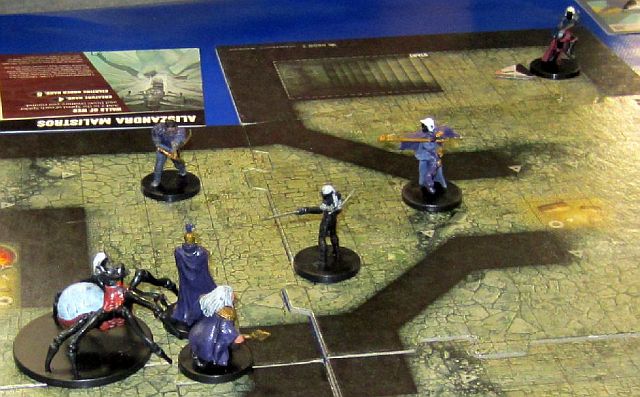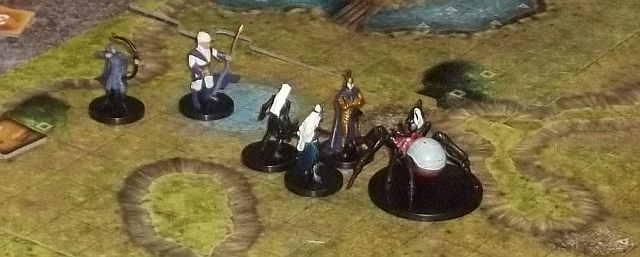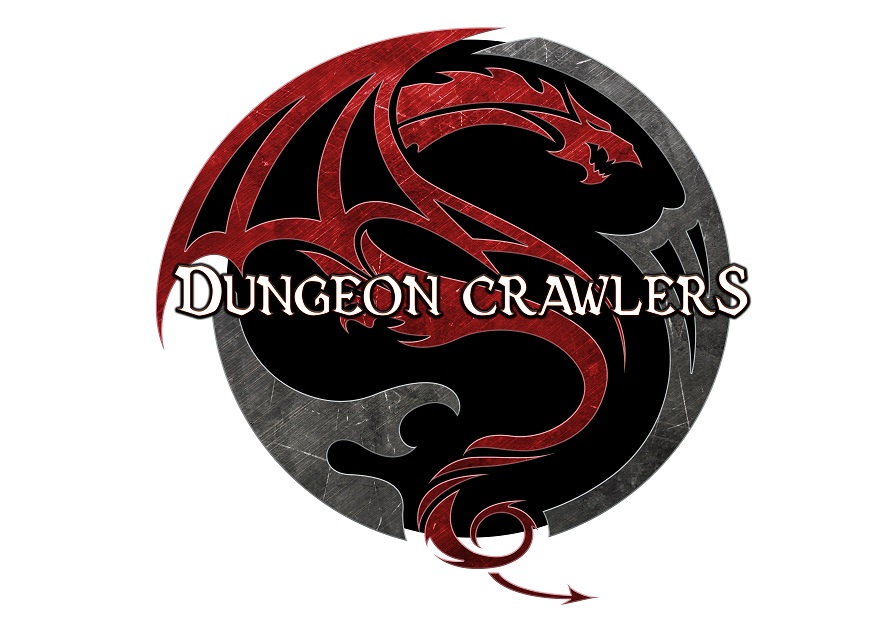|
The game Dungeon Command is a miniatures skirmish game by Wizards of the Coast for two to four players. It takes about 20-40 minutes to play the two-player game, which this review will address. A chief concept in Dungeon Command is that each player maintains their own warband; it is a customisable game. Players construct their warbands from creatures, order cards, map tiles and commander cards. The game is sold in set called faction packs. At the time of writing, only the first three: Sting of Lolth, Heart of Cormyr, And Tyranny of Goblins are available. It is worth noting that miniature games, like trading card games, tend to require a moderate buy-in cost. It isn't the same paradigm as a board game where you get everything you need for all players in one box. You can play a starter scenario using just one faction box, but it won't really give you the full experience of the game. One faction box per player is really the minimum for really interesting game play. There are a number of design decisions in Dungeon Command that distinguish it from other miniature games I've played. I'm not a big player of miniature games, although I've played a some D&D Miniatures, MageKnight and Heroclix over the years. Let's have a look at them and how they add to the game. This review does not contain a detailed description of the rules and gameplay. This review looks at elements that I believe are notable about the Dungeon Command game. No Dice, just Cards Dungeon Command doesn't use dice to determine success. Instead, all creatures do set damage with basic attacks. Order cards allow more effective attacks, special maneuvers, or defensive parries. If you and your opponent have no cards in hand, you know exactly what the result of your attacks will be. However, if your opponent has a card in hand, then comes some uncertainty. Is it a powerful attack? Will it allow a counter to my play? The game will also work if you don’t use any cards, in the same way that Chess works: it is a game about positioning and maneuvering. The cards allow for more variety of action than the basic 'Chess' game, as well as providing uncertainty as to results. Cards have requirements to play. Each creature has a level and a list of attributes, which the card has to match. A Level 2 STR creature can't play a Level 1 DEX card. The cards for each attribute emphasize different effects, and some cards relax requirements to allow play by creatures of a certain type: Spiders, for instance, can play "Web" despite them being DEX creatures rather than the INT required by the card. I didn't expect this design decision for this game, but it has proved to be an inspired one. It has become very frustrating over the years with a single dice roll determining a game, despite all the good play on a player's part. In this game, controlling the timing of the game (and thus players' access to cards) can be crucial. It should also be noted that each faction has one commander that helps you gain access to more order cards (or at least better quality cards). Growing Your Warband Each player has a leadership score that is based on the commander they've chosen (each set comes with two choices). This score increases at the end of each turn, and determines the maximum levels of creatures you can control on the battlefield at one time. This means that when a creature dies, the hole it creates can be filled with an equally powerful creature. Unlike D&D Miniatures and Heroclix, your entire force doesn't begin on the battlefield. Instead, you start with a small portion of your force and play new creatures as the game continues. There isn't a death spiral where once you start losing, you'll continue losing because you have fewer creatures than your opponent: instead, you'll have equivalent forces for the entire battle, keeping the game interesting until the end. If there's one design decision that I think really makes this game special, this is it. Morale, Treasure, and Cowering If you always have creatures on the battlefield, with new ones being played to replace those lost, how do you win the game? A second rating that of Morale covers this. Morale is lost when a creature is killed, an amount equal to the killed creature's level. Once your Morale reaches zero, then you lose the game. (It is also possible that when one player has no creatures left on the battlefield, in which case whoever has the higher Morale wins). That's easy enough; however, the addition of Treasure and Cowering make the game tactically richer. Six treasure piles are placed around the board at the beginning of the game. By picking them up, you can increase your morale. You can also save a creature from dying by cowering - you lose morale to prevent the damage. These rules work really well. I've seen fast movement creatures - though weak in combat - gather enough treasure to take victory because the slow-moving force against them couldn't kill enough to make up the difference. I've also seen players take 3 morale hits to protect a Level 2 creature because the positioning of that creature was important and losing it would hurt more than the morale hit. A Game and Three Expansions Apart from the primary Dungeon Command game, a set also comes with 12 cards for using the miniatures in the D&D Adventure System games - Castle Ravenloft, Wrath of Ashardalon and Legend of Drizzt. The Sting of Lolth set provides more monsters for your foes to face, but the Heart of Cormyr set introduces a new mechanic: the Ally, which adds a new encounter card to the mix that allows one of the miniatures to join your forces as a non-player 'Hero'. And, of course, the miniatures are also of the proper scale to add them to a Dungeons & Dragons role-playing game (or the Fantasy RPG of your choice). Heart of Cormyr gives you a selection of heroic miniatures, while Sting of Lolth is a drow-themed set that is particularly useful at present, it being the "Year of the Underdark" for D&D products from Wizards of the Coast, and the Tyranny of Goblins gives you an assortment of goblins, a troll, and Devil to play with. Customization of Forces
A starting box comes with 12 miniatures and 36 order cards, along with 2 commanders and 4 tiles. Each player requires 12 miniatures, 30 order cards, 1 commander and 4 tiles, so there is a small amount of customization available immediately. It just isn't that interesting. Once you add a second box to your collection, you have a lot more meaningful options. You are restricted to having four copies of any card or miniature in your warband, and you get one or two copies of each in a faction box. Getting four of everything is likely to be frustrating, as you'll have a lot of duplicate components you don't need. The secondary market will likely help there, especially due to the separate markets the components have: the order cards are only useful to Dungeon Command players, as people wanting the miniatures for D&D or the Adventure System board games won't need them. Component Quality All of the components in Dungeon Command are quite attractive to look at, although I've seen better prepainted miniatures than those in these sets. I very much appreciate how durable the miniatures are; they are attractive enough for my purposes, although good miniature painters could do a much better job. The dungeon tiles have artwork by Jason Engle, who has been designing tiles for the D&D game for many years now. I love the design of his tiles and these ones look very good. I, and others, have noticed slight warping of the tiles in moist conditions, just enough to prove troublesome. This is disappointing, to say the least. The tiles are double-sided, with wilderness on one side and a dungeon on the other. I particularly like the set-up tiles, which depict entrances/exits from the caves and castles for the various factions. There are several terrain types on the tiles, which make for variety in the battles. The cards - unlike those in the Adventure System games - are full color and all have original art on them. They really look very nice, and I appreciate that the creature cards have pictures of the miniatures for identification purposes. The Right Amount of Luck? Although Dungeon Command does not have chance-based resolution of effects, the game does still possess uncertainty, primarily in the order of creature cards and order cards drawn to hand; you can't play a creature if you haven't drawn it, likewise with the order cards. Not everyone is going to appreciate this method, which is also used in such games as Magic and Summoner Wars. I enjoy managing chaos (rather than being managed by chaos, which is how I feel about luck-based resolution at times), and the amount of unpredictability in your draws can be ameliorated by the customization of the game and the way you can replace dead creatures. However, there will be times where your draw just works against you. It is something to be aware of before you play this game. Conclusion As I played more and more of Dungeon Command in preparation for this review, I realized how good the design is. "Good" then became "Great": I really enjoy this game! The game solves problems I've had with miniature skirmish games before, and does it with solutions that are elegant and effective. The way you can reinforce your warband, the cowering rules, and the card-based gameplay make for a game that I really enjoy. Dungeon Command is an exceptional game, and I am eagerly awaiting the release of new sets so I can see more of what is possible in the game.
3 Comments
3/8/2013 04:48:26 pm
I'm impressed by your review, So, would like to check it out.
Reply
3/29/2013 11:11:20 am
Reply
Leave a Reply. |
Archives
August 2021
Categories
All
|



 RSS Feed
RSS Feed








